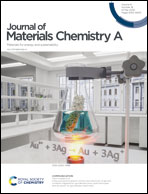MOF-derived Fe,Co@N–C bifunctional oxygen electrocatalysts for Zn–air batteries†
Abstract
Zn–air batteries (ZABs) have attracted considerable attention due to the growing requirement for energy storage systems with high-energy density and safety. Meanwhile, the reasonable design of robust and cut-price bifunctional oxygen electrocatalysts is greatly desired for ZABs. Herein, a simple method to develop MOF (metal–organic framework)-derived hierarchical Fe,Co@N–C materials (FeCo–N–C-T), has been developed for effectively electrocatalyzing the oxygen reduction reaction (ORR) and oxygen evolution reaction (OER) based on ZnCo–ZIFs encapsulated with Fe-doped glucosamine (ZnCo–ZIF@Fe/glucosamine). Compared with commercial Pt/C and RuO2, the newly developed FeCo–N–C-700 exhibited superior electrocatalytic properties for the ORR (half-wave potential of 0.896 V) and OER (overpotential of 370 mV at 10 mA cm−2) and a reversible oxygen overpotential of 0.71 V. Simultaneously, it was demonstrated that the combination of Fe and Co showed synergistic improvements on the bifunctional activity. As a proof of concept, liquid- and solid-state Zn–air batteries (ZABs) were fabricated with FeCo–N–C-700 as air-cathodes. The developed liquid-ZABs exhibited an ultrahigh peak power density (150 mW cm−2 at 240 mA cm−2) and robust cycling stability (no obvious decay after more than 360 Please change to–discharging cycles), outperforming those based on commercial Pt/C + RuO2. As expected, all-solid-state ZABs based on FeCo–N–C-700 exhibited excellent reversibility and durability. In addition, density functional theory (DFT) investigations revealed that FeCoN8 was more active than Fe/CoN4 for the ORR and OER, indicating the synergetic effect of the Fe and Co active sites in FeCo–N–C-700 affording superior electrocatalytic performance.



 Please wait while we load your content...
Please wait while we load your content...